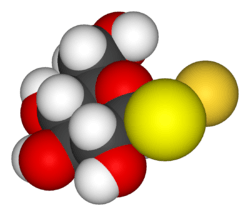Aurothioglucose
 | |
 | |
| Clinical data | |
|---|---|
| AHFS/Drugs.com | Consumer Drug Information |
| Routes of administration | Intramuscular injection |
| ATC code | M01CB04 (WHO) |
| Pharmacokinetic data | |
| Bioavailability | 0% |
| Identifiers | |
| |
| Synonyms | Gold thioglucose, Solganal, Auromyose |
| CAS Number |
12192-57-3 |
| PubChem (CID) | 6104 |
| ChemSpider |
16738764 |
| UNII |
2P2V9Q0E78 |
| ChEMBL |
CHEMBL1697725 |
| Chemical and physical data | |
| Formula | C6H11AuO5S |
| Molar mass | 392.181 g/mol |
| 3D model (Jmol) | Interactive image |
| |
| |
| | |
Aurothioglucose, also known as gold thioglucose, is a chemical compound with the formula AuSC6H11O5. This derivative of the sugar glucose was formerly used to treat rheumatoid arthritis.
History
Throughout history, gold was used to cure diseases, although the efficacy was not established. In 1935, gold drugs were reported to be effective for the treatment of rheumatoid arthritis.[1] Although many patients reacted positively to the drug, gold thioglucose was not uniformly effective.
Three gold drugs remain in active clinical use for this purpose in the United States: auranofin, sodium aurothiomalate (gold sodium thiomalate) and aurothioglucose. In the United Kingdom, only sodium aurothiomalate and auranofin are used.
In 2001, aurothioglucose was withdrawn from the Dutch market, where it had been the only injectable gold preparation available since 1943, forcing hospitals to change medication for a large number of patients to aurothiomalate.[2] The drug had been in use for more than 70 years, and four years later the reasons for its sudden disappearance remained unclear.[3]
Medicinal chemistry
Gold thioglucose features gold in the oxidation state of +I, like other gold thiolates. It is a water-soluble, non-ionic species that is assumed to exist as a polymer.[1] Under physiological conditions, an oxidation-reduction reaction leads to the formation of metallic gold and sulfinic acid derivative of thioglucose.
- 2 AuSTg → 2 Au + TgSSTg
- TgSSTg + H2O → TgSOH + TgSH
- 2 TgSOH → TgSO2H + TgSH
- Overall: 2 H2O + 4 AuSTg → 4 Au + TgSO2H + 3 TgSH
(where AuSTg = gold thioglucose, TgSSTg = thioglucose disulfide, TgSO2H = sulfinic acid derivative of thioglucose)
Preparation
Gold thioglucose can be prepared by treating gold bromide with thioglucose solution saturated with sulfur dioxide. Gold thioglucose is precipitated with methanol and recrystallized with water and methanol.
Miscellaneous observations
In recent research, it was found that injection of gold thioglucose induces obesity in mice.[4] Aurothioglucose has an interaction with the antimalarial medication hydroxychloroquine.
See also
References
- 1 2 Shaw, III C. F. (1999). "Gold-Based Therapeutic Agents". Chemical Reviews. 99 (9): 2589–600. doi:10.1021/cr980431o. PMID 11749494.
- ↑ Parenteral gold preparations. Efficacy and safety of therapy after switching from aurothioglucose to aurothiomalate (van Roon et al., J Rheumatol 2005)
- ↑ Klinkhoff, A (2005). "An editorial is a golden opportunity". The Journal of rheumatology. 32 (6): 978–9. PMID 15940754.
- ↑ Naruta E, Buko V (2001). "Hypolipidemic effect of pantothenic acid derivatives in mice with hypothalamic obesity induced by aurothioglucose.". Exp Toxicol Pathol. 53 (5): 393–8. doi:10.1078/0940-2993-00205. PMID 11817109.
External links
![]() Media related to Aurothioglucose at Wikimedia Commons
Media related to Aurothioglucose at Wikimedia Commons